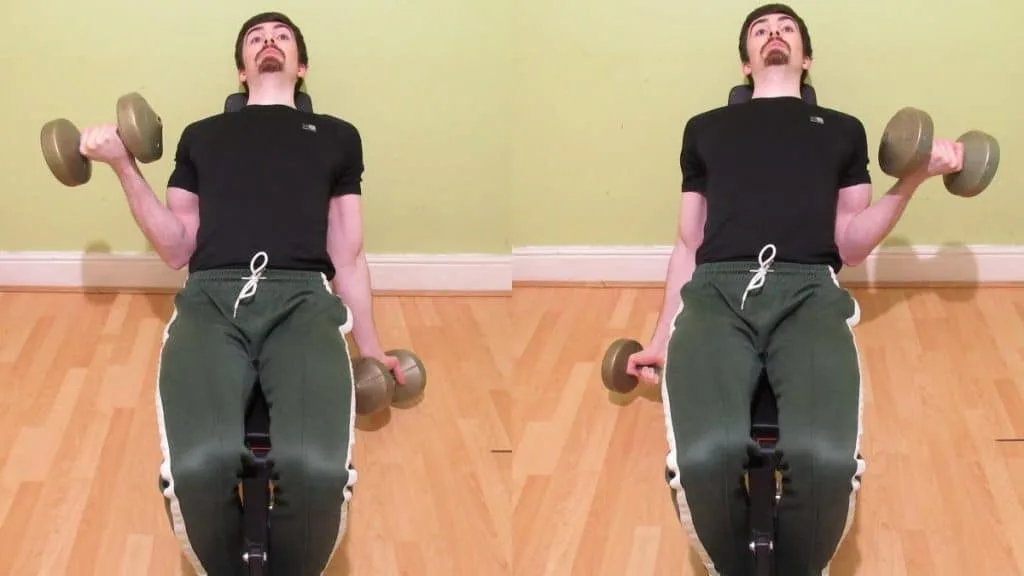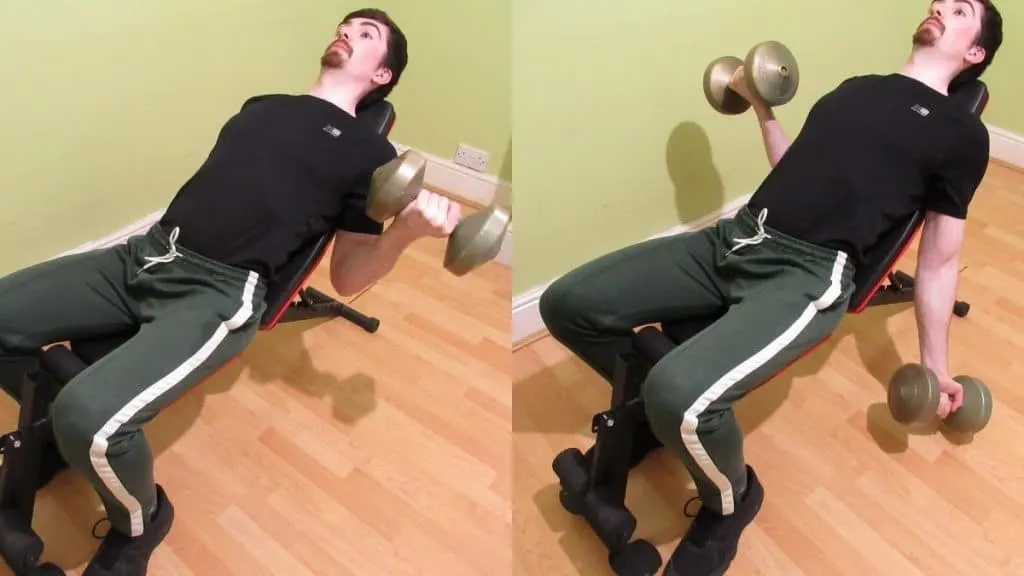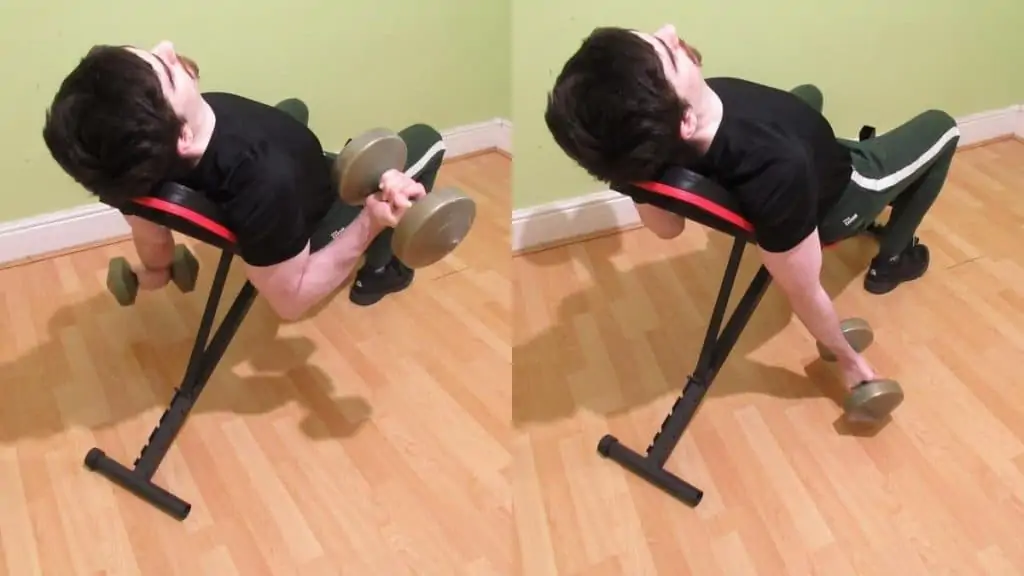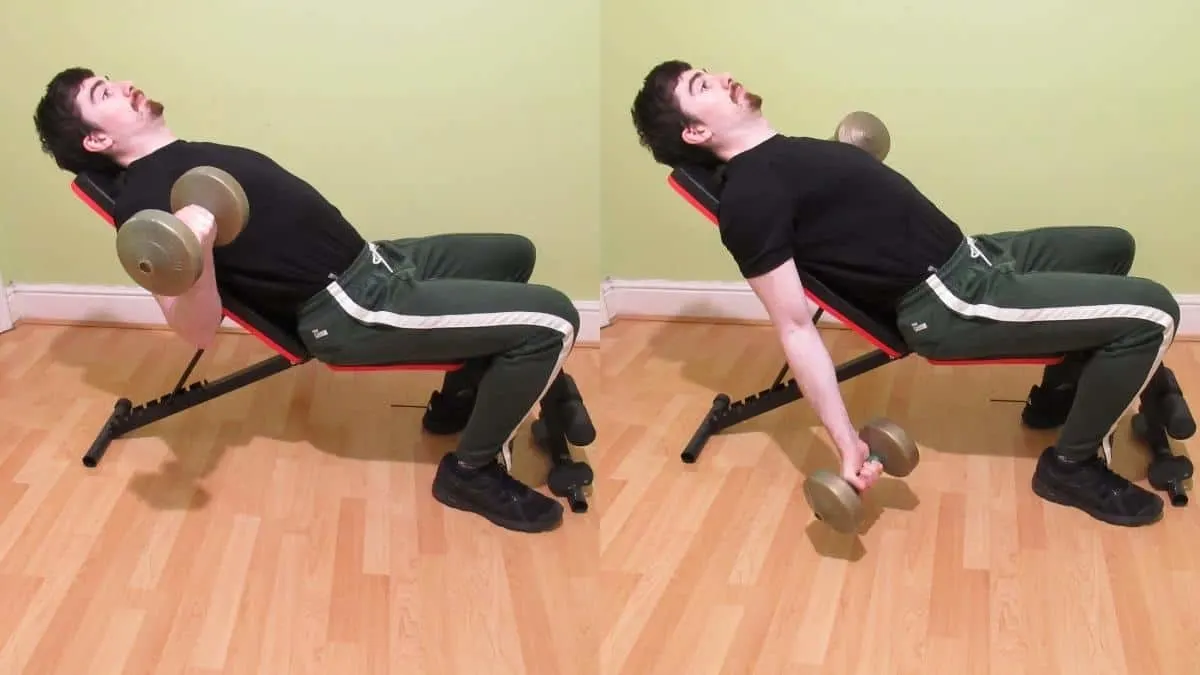Incline alternating dumbbell curls are a popular exercise for building the biceps brachii because they enable you to perform more reps than the regular version. This is because your biceps get a short rest in the alternate variation as the opposing bicep is working.
This guide explains the correct lifting technique and then discusses the pros and cons of performing the incline alternating dumbbell curl instead of standard incline curls.
Related: Chest and biceps workout routine
Alternate incline dumbbell curl exercise details
- Main Muscles: Biceps brachii
- Secondary Muscles: Forearm flexors, brachioradialis, brachialis
- Exercise Type: Strength
- Exercise Mechanics: Isolation
- Difficulty Level: Intermediate
- Equipment Needed: Adjustable bench, dumbbells
How to do incline alternating dumbbell curls
- Set the back pad of an adjustable bench to a 45-degree or 60-degree angle.
- Grab two dumbbells with an underhand grip and then sit on the bench.
- Pin your shoulder blades against the backrest and let the weights hang by either side of the bench, just behind your torso.
- Curl one dumbbell toward your shoulder with a supinated grip while keeping your elbow still.
- Squeeze your bicep forcefully as it comes into contact with the underside of your forearm.
- Lower the weight under control until your elbows are completely locked out.
- Repeat the motion with your other arm, and perform 3-5 sets of 6-12 reps per side.
Alternate incline dumbbell curl pros and cons
Like the cable alternating curl, alternating incline dumbbell curls provide your biceps with consistent resistance throughout the entire duration of the rep. However, since the free-weight version is more convenient, it’s the top choice for many lifters, despite having its own pros and cons.
Pro: Provides more training volume

Training volume is the total amount of work that a given muscle or group of muscles perform over the course of a week or month. It’s often thought of as sets x reps x weight and is of paramount importance for building muscle. [1]
Alternate incline dumbbell curls enable you to perform more reps (and thereby accumulate extra training volume) than the regular two-arm version. This is because your bicep gets a chance to rest while the opposing bicep is performing its rep.
As such, your biceps are naturally fresher and stronger for their next repetition, which means that you can do more reps per set and potentially also lift heavier weights, both of which bump up your training volume.
Just make sure that you don’t rest for too long between arms. A 1-2 second pause between the completion of one rep and the beginning of the other rep is the sweet spot. Anything more, and you’re stepping into rest-pause training territory.
To work your biceps from a different angle, you can also do the incline inner biceps curl, which may help you to attain a deeper muscle stretch.
Pro: May improve your mind-muscle connection

Performing incline alternating dumbbell curls may help to improve your mind-muscle connection, which is another vital aspect of hypertrophy training. This is because it’s easier to focus on the working muscle when you only have to lift one dumbbell at a time, which is also the case with standing alternating dumbbell curls.
As such, you can put every ounce of energy and effort into blasting the particular bicep that you’re currently working on. And by blasting, I mean contracting the muscle as hard as possible and then lowering the weight for a full bicep stretch.
You may also find that you’re stronger when you train one arm at a time for much the same reason. When your brain only has to focus on moving a single limb, your central nervous system can put all of its force toward working the arm that’s currently lifting the weight.
If you want to build your brachialis and brachioradialis muscles in addition to your biceps, then you can also give alternating DB hammer curls a try. If, however, you want to take your biceps out of the movement as much as possible, then the incline dumbbell reverse curl is your best bet.
Con: The technique is more challenging

Despite the undeniable advantages of the alternating incline dumbbell curl, many lifters screw up on the technique. And I’m not talking about doing this exercise with a twist because that’s certainly another variation that you can do (the other option is to keep your palms supinated throughout the whole rep).
I’m saying that incline alternating dumbbell curls leave you open to using sloppy form.
Specifically, when you have to think about lowering one dumbbell and then immediately lifting the other, it can be tempting to shortcut the range of motion on the arm that you’re currently training in order to start your next rep sooner.
This practice leads to less muscle growth because by performing partial reps, you won’t be recruiting as many muscle fibers as if you did full reps.
Instead, make sure that you lower the dumbbell all the way down before beginning your next rep. If it helps, you can actually flex your triceps at the bottom of the rep to ensure that your biceps are fully lengthened/stretched.
Read More: Best bicep workouts for definition │Abs back biceps workout
The verdict: Is the alternating incline dumbbell curl better than the regular version?
The alternate incline dumbbell curl enables you to perform more reps than the regular version because your biceps get a brief rest after each repetition, which is also true for preacher alternating curls.
The drawback is that the alternating version has more room for error. Many trainees use an incorrect lifting rhythm and thus shortchange themselves by starting their second rep before they’ve finished their first. As mentioned, this mistake leads to less muscle stimulation because you’re not getting a full range of motion. [2]
It’s also harder to track your reps for the alternating incline dumbbell curl since you’ll naturally be performing more repetitions in total. Overall, though, both exercises are about equal. The most important thing is that you train consistently and use the proper form.
References
- Beardsley, C. (2018, July 12). What is training volume? – Chris Beardsley. Medium. https://sandcresearch.medium.com/what-is-training-volume-286b8da6f427
- Dupont, D. (2020, June 3). Science Says Full Range of Motion Is Best. Breaking Muscle. https://breakingmuscle.com/fitness/science-says-full-range-of-motion-is-best

